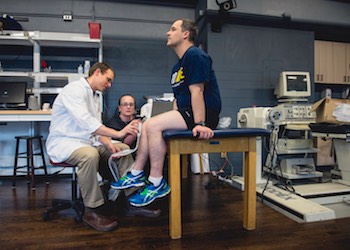Dr. Kristi Streeter's Research
Cervical spinal cord injury disrupts descending drive to the primary inspiratory muscle, the diaphragm, and results in profound breathing impairments. Individuals with cervical spinal cord injury are also at the highest risk for developing aberrant sympathetically driven cardiovascular responses. Respiratory afferents are known to influence both respiratory motor output and cardiovascular control. Dr. Streeter’s research program is focused on understanding the role of respiratory afferents in cardiorespiratory control, the mechanisms by which afferents induce respiratory motor plasticity, and the therapeutic potential of respiratory afferent activation after cervical spinal cord injury.
It is well established that the spinal cord exhibits a considerable amount of plasticity, which can promote functional recovery following neurologic conditions such as spinal cord injury. Recent work has confirmed respiratory afferent projections terminate within the spinal cord near respiratory related neurons. The fundamental hypothesis guiding our work is that respiratory afferents induce spinal plasticity and facilitate remodeling within the respiratory neural network. Our laboratory uses a multi-disciplinary approach including behavioral studies, neurophysiological preparations, and molecular techniques to investigate the functional significance and therapeutic potential of respiratory afferent activation, with the ultimate goal of identifying novel rehabilitative strategies to improve cardiorespiratory control following cervical spinal cord injury
Select Publications
- Streeter KA, Sunshine MD, Brant JO, Sandoval AGW, Maden M, Fuller DD (2019). Molecular and histologic outcomes indicate reduced wounding following spinal cord injury in spiny mice Acomys cahirinus. J. Comp. Neurol.
- Streeter KA, Sunshine MD, Patel SR, Gonzalez-Rothi EJ, Reier PJ, Baekey DM, Fuller DD (2019). Mid-cervical interneuron networks following high cervical spinal cord injury. Physiol. Neurobiol. In press. PMID: 31553921.
- Turner S, Streeter K, Greer J, Mitchell GS, Fuller DD (2018). Pharmacologic modulation of hypoxia-induced respiratory neuroplasticity. Physiol. Neurobiol. 256: 4-14. PMID: 29197629.
- Nair J, Streeter KA, Turner SMF, Sunshine MD, Bolser D, Davenport P, Fuller DD (2017). Phrenic afferents and control of breathing. Neurophysiol. 118(6):2975-2990. PMID: 28835527.
- Streeter KA*, Sunshine MD*, Patel SR, Gonzalez-Rothi EJ, Reier PJ, Baekey DM, Fuller DD (2017). Intermittent Hypoxia Enhances Functional Connectivity of Mid-Cervical Spinal Interneurons. Neurosci. 37(35):8349-8362. PMID: 28751456.
- Streeter KA, Sunshine MD, Patel SR, Liddell SP, Denholtz LE, Reier PJ, Fuller DD, Baekey DM (2017). Coupling multi-electrode array recordings with silver labeling of recording sites to study cervical spinal network connectivity. Neurophysiol 117(3):1014-1029. PMID: 27974450.
- Gonzalez-Rothi EJ, Streeter KA, Hanna MH, Stamas AC, Reier PJ, Baekey DM, Fuller DD (2016). High frequency epidural stimulation evokes short-term potentiation of phrenic discharge after incomplete cervical spinal cord injury. Neurophysiol. 118(4): 2344-2357. PMID: 28615341.
- Mercier LM, Gonzalez-Rothi EJ, Streeter KA, Posgai SP, Poirier AS, Fuller DD, Reier PJ, Baekey DM (2016). Intraspinal microstimulation and diaphragm activation following cervical spinal cord injury. Neurophysiol. 117(2):767-776. PMID: 27881723.




